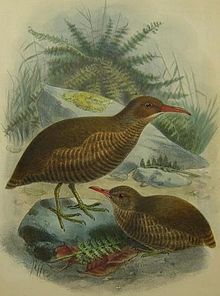| Chatham Islands rail | |
|---|---|

| |
| Illustration by Keulemans | |
| Conservation status | |
 Extinct (c.1900) (IUCN 3.1) | |
 Extinct (c.1900) (NZ TCS) | |
| Scientific classification | |
| Domain: | Eukaryota |
| Kingdom: | Animalia |
| Phylum: | Chordata |
| Class: | Aves |
| Order: | Gruiformes |
| Family: | Rallidae |
| Genus: | Cabalus |
| Species: | †C. modestus |
| Binomial name | |
| †Cabalus modestus (Hutton, 1872) | |
| Synonyms | |
| |
The Chatham Islands rail (Cabalus modestus), also known as the Chatham rail is an extinct flightless species of bird in the family Rallidae. It was endemic to Chatham, Mangere and Pitt Islands, in the Chatham archipelago of New Zealand. The Chatham Islands rail was first discovered on Mangere in 1871, and 26 specimens collected there are known from museum collections. Its Māori name was "mātirakahu".
Taxonomy


The Chatham Islands rail and the Dieffenbach's rail, both extinct and flightless, were sympatric on the Chatham Islands. Their sympatry suggests parallel evolution after separate colonisation of the Chatham Islands by different rail ancestors. A genetic analysis from 1997 suggested that the two were sister taxa. However more recent genetic analysis finds them to not be closely related within the Gallirallus radiation, with a 2014 analysis finding the Chatham Islands rail being sister taxon to the possibly extinct New Caledonian rail instead.

Extinction
It became extinct on the island between 1896 and 1900. The species is also known from 19th century bones from Chatham and Pitt Islands. It is likely to have occurred in scrubland and tussock grass. Its extinction was presumably caused by predation by rats and cats (which were introduced in the 1890s), habitat destruction to provide sheep pasture (which destroyed all the island's bush and tussock grass by 1900), and from grazing by goats and rabbits. On Chatham and Pitt Islands, Olson has suggested that its extinction resulted from competition with the larger Dieffenbach's rail (also extinct), but this has been refuted later when the two species have been shown to have been sympatric on Mangere.
- Various views of the skull of the Chatham Islands rail
-
 Lateral view
Lateral view
-
 Dorsal view
Dorsal view
-
 Ventral view
Ventral view
-
 Oblique view
Oblique view
See also
- Hawkins's rail, another extinct flightless rail endemic to the Chatham Islands.
References
- BirdLife International (2016). "Cabalus modestus". IUCN Red List of Threatened Species. 2016: e.T22728873A94999473. doi:10.2305/IUCN.UK.2016-3.RLTS.T22728873A94999473.en. Retrieved 11 November 2021.
- ^ "Cabalus modestus. NZTCS". nztcs.org.nz. Retrieved 22 August 2023.
- Marchant and Higgins (1993)
- Trewick, S.A. (1997). "Sympatric flightless rails Gallirallus dieffenbachiii and G. modestus on the Chatham Islands, New Zealand; morphometrics and alternative evolutionary scenarios". Journal of the Royal Society of New Zealand. 27 (4): 451–464. Bibcode:1997JRSNZ..27..451T. doi:10.1080/03014223.1997.9517548.
- Trewick SA. 1997. Flightlessness and phylogeny amongst endemic rails (Aves: Rallidae) of the New Zealand region. Philosophical Transactions of the Royal Society. 352:429–446.
- Garcia-R, Juan C.; Gibb, Gillian C.; Trewick, Steve A. (December 2014). "Deep global evolutionary radiation in birds: Diversification and trait evolution in the cosmopolitan bird family Rallidae". Molecular Phylogenetics and Evolution. 81: 96–108. doi:10.1016/j.ympev.2014.09.008. PMID 25255711.
- Tennyson and Millener (1994)
- Olson (1975c)
External links
- [REDACTED] Media related to Gallirallus modestus at Wikimedia Commons
- Specimens from the Museum of New Zealand Te Papa Tongarewa.
- Specimens from the Auckland War Memorial Museum Tāmaki Paenga Hira
| Taxon identifiers | |
|---|---|
| Gallirallus modestus | |
| Rallus modestus | |
This Gruiformes-related article is a stub. You can help Misplaced Pages by expanding it. |

